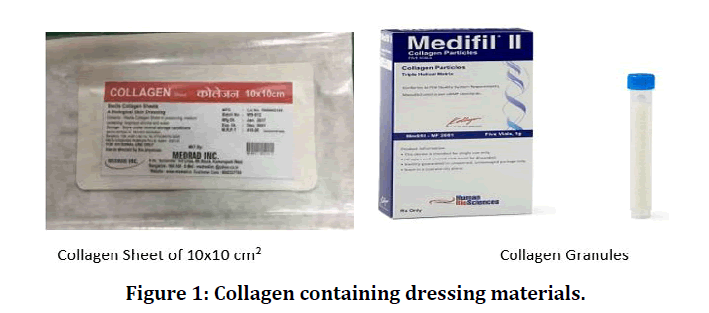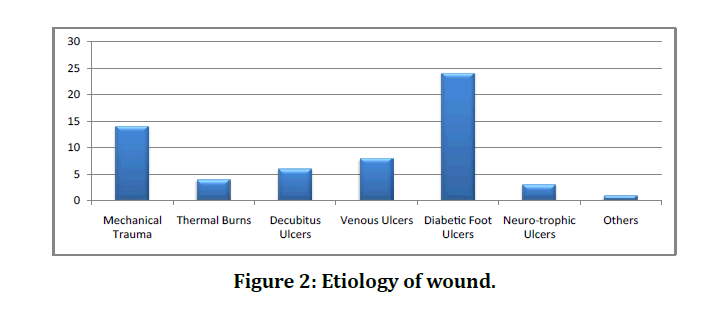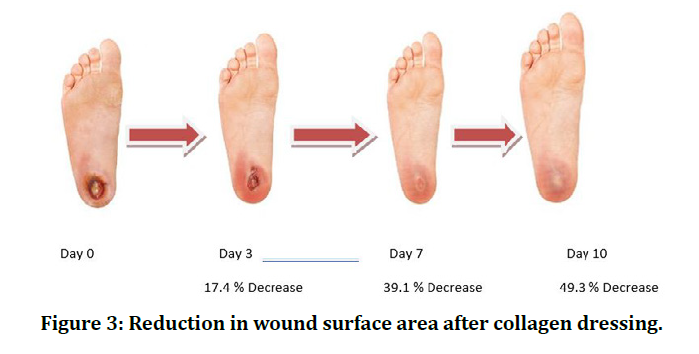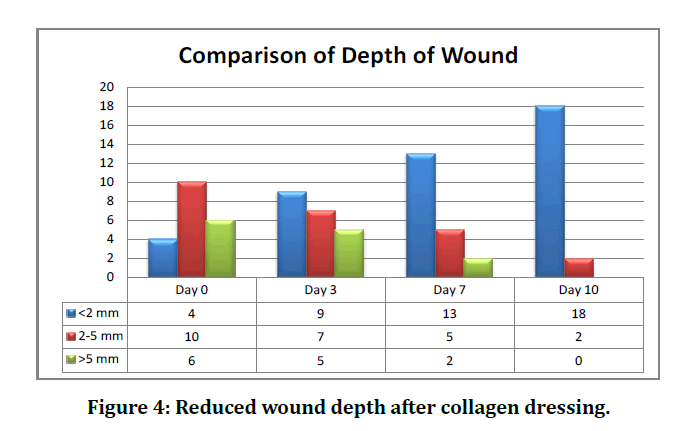Research - (2020) Advances in Dental Surgery
Study of Collagen Based Dressing for Wound Healing
Prashant N Mukadam, Dip H Joshi, Jaykumar J Mandanka*, Parth C Shah and Zeel U Khandla
*Correspondence: Jaykumar J Mandanka, Department of General Surgery, AMCMET medical college, Affiliated to L.G. Hospital, Ahmedabad, India, Email:
Abstract
Background and Objective: In past few centuries, medicine is so much advanced despite that management of chronic wounds remains a tough challenge. To solve this, a lot of modalities of dressings and local applicants have been developed. Continued research for good functional biological dressings resulted in the evolution of collagen-based dressings for wounds which have proven to be superior. Collagen dressings possess properties, which lend themselves to creating a wound environment favorable to the migration of cells from the epidermal margin across granulation tissue, encouraging wound closure. Methodology: A total of 50 cases clinically presenting as ulcer between June 2017 and July 2019 were taken for study. Each case was examined clinically in systematic manner as per the proforma. Collagen based dressing was used and outcome was measured by recording wound scores on days 3, 7 and 10. Interpretation and conclusion: In our study, Collagen based dressing materials enhanced wound healing, and faster recovery. These materials are promising new technology in the field of wound healing with multiple applications in a variety of wounds and can be used in both acute and chronic wounds.
Keywords
Biological dressing, Collagen, Chronic wound
Introduction
What is a wound? From a scratch on a finger to an ulcer that covers the entire lower limb. In past few centuries, medicine is so much advanced despite that management of chronic wounds remains a tough challenge. To solve this, a lot of modalities of dressings and local applicants have been developed and a lot of studies are still going on.
All the surgeons during their practice will come across the problem of infection and ulcer. The surgical practice primarily depends upon the healing of wound without serious Complication. This can have significant effects on the patient mortality and morbidity.
To solve this lot of modalities of dressings and local applicants have been developed and lot of studies are still going on. Wounds which are showing characters of delayed healing or non-healing is a problem which given rise to various complications in addition to financial and psychological burden. To find healing treatments, complementary methods have been developed.
Collagen based dressing in chronic wound
There are several different collagen dressings available such as gels, pastes, polymers, oxidized regenerated cellulose (ORC) etc. The collagen within these products tends to be derived from bovine, porcine, equine, or avian sources, which is purified to render it non-antigenic [1]. The collagen in each collagen dressing can vary in concentration and type. Collagen dressings have a variety of pore sizes and surface areas, as well. All these attributes are meant to enhance the wound management aspects of the dressings. Many collagen dressings contain an antimicrobial agent to control pathogens within the wound [2].
Research has shown that some collagen-based dressings produce a significant increase in the fibroblast production; have a hydrophilic property that may be important in encouraging fibroblast permeation enhance the deposition of oriented, organized collagen fibers by attracting fibroblasts and causing a directed migration of cells; aid in the uptake and bioavailability of fibronectin; help preserve leukocytes, macrophages, fibroblasts, and epithelial cells; and assist in the maintenance of the chemical and thermostatic microenvironment of the wound. The Mechanism of action of several collagen dressings includes the inhibition or deactivation excess MMPs. As mentioned, excess MMPs are a key contributor to wound chronicity [3] (Figure 1).

Figure 1: Collagen containing dressing materials.
Methodology
Source of data
Patients presented with ulcers, admitted under general surgery department at LG General Hospital, Maninagar, Ahmedabad between June 2017 to September 2019 were enrolled with this study with their consents.
Type of study
Prospective study.
Sample size
Total 60 patients were included in this study. All patients was managed using Collagen based dressing (Medifill Collagen Granules).
Inclusion criteria
Patients presenting with ulcers.
Patients more than 12 years of age.
Exclusion criteria
Patients less than 12 years of age.
Patients who were managed on outpatient basis.
Patients not giving consents of newer modality of dressing.
Patients having.
Untreated Osteomylitis.
Malignancy in the wound.
Entero-cutenous fistula.
Clinical examination of each case was done systematically as per the proforma drafted for the study. The outcome was measured using parameters like wound surface area, colour and consistency of granulation tissue, depth of the wound, pain score and duration of hospital stay.
Method of collection of data
Any dressing from the wound was removed. A culture swab for microbiology was taken. Wound was irrigated with normal saline. Surgical debridement was done and adequate haemostasis achieved. Medifill Collagen Granules (Manufactured by Human Bioscience Limited, India) were applied generously on it, as shown in the picture below.
Wound was closed using occlusive dressing and re-opened after 3 days. Wound surface area and depth of the wound were examined on day 3, 7 and 10.
Results
Age distribution
Most of the patients presenting with wounds were in the 5th decade of life 20 (33.3%), followed by the 6th decade 18 (30%) (Table 1).
| Age Group | No. of Patients |
|---|---|
| <30 years | 3 (5%) |
| 30-40 years | 11 (18.3%) |
| 40-50 years | 20 (33.3%) |
| 50-60 years | 18 (30%) |
| >60 years | 8 (13.3%) |
| Total | 60 |
Table 1: Age distribution of patients in this study.
Gender distribution
Wounds were more common in males (48 cases - 80%) than in females (12 cases - 24%) with Male to female ratio being 4:1 (Table 2).
| Gender | No. of Patients |
|---|---|
| Male | 48 (80%) |
| Female | 12 (20%) |
| Total | 60 |
Table 2: Gender distribution in study.
Distribution of location of wound
Wound were most located on leg (31 cases-51.7%), followed by foot (20 cases-33.3%) (Table 3).
| Location of Wound | No. of Cases |
|---|---|
| Forearm | 2 (3.3%) |
| Abdomen | 4 (6.7%) |
| Buttocks | 1 (1.7%) |
| Leg | 31 (51.7%) |
| Foot | 20 (33.3%) |
| Sole | 2 (3.3%) |
| Total | 60 |
Table 3: Location of wound in this study.
Aetiology of wound
Based on aetiology of wounds, which were determined by history and clinical examination, wounds were divided into different groups. A major portion of 24 cases (40%) fell into diabetic foot ulcer (Table 4 and Figure 2).

Figure 2: Etiology of wound.
| Aetiology of wound | No. Of cases |
|---|---|
| Mechanical Trauma | 14 (23.3%) |
| Thermal Burns | 4 (6.7%) |
| Decubitus Ulcers | 6 (10%) |
| Venous Ulcers | 8 (13.3%) |
| Diabetic Foot Ulcers | 24 (40%) |
| Neuro-trophic Ulcers | 3 (5%) |
| Others | 1 (1.7%) |
| Total | 60 |
Table 4: Aetiology of wound.
Outcomes of collagen-based dressing (Tables 5 and 6, Figures 3 and 4).

Figure 3: Reduction in wound surface area after collagen dressing.

Figure 4: Reduced wound depth after collagen dressing.
| Days after collagen application | Number of Cases | ||
|---|---|---|---|
| <20 cm2 | 20-40 cm2 | >40 cm2 | |
| Day 0 | 4 | 10 | 6 |
| Day 3 | 7 | 9 | 4 |
| Day 5 | 12 | 6 | 2 |
| Day 10 | 15 | 5 | 0 |
Table 5: Comparison of wound surface area.
| Days after collagen application | Number of Cases | ||
|---|---|---|---|
| <2 mm | 2-5 mm | >5 mm | |
| Day 0 | 4 | 10 | 6 |
| Day 3 | 9 | 7 | 5 |
| Day 7 | 13 | 5 | 2 |
| Day 10 | 18 | 2 | 0 |
Table 6: Comparison of depth of wound.
Discussion
Chronic wounds take a longer time for healing as all chronic wounds have elevated levels of matrix metalloproteinases, which result in increased proteolytic activity and inactivation of the growth factors involved in the woundhealing process. Thus, a chronic wound due to any cause is a situation that needs the use of a temporary cover for the raw surface. The use of collagen dressing has been found to inhibit the action of metalloproteinases [4].
Collagen is a biomaterial that encourages wound healing through deposition and organization of freshly formed fibres and granulation tissue in the wound bed thus creating a good environment for wound healing [5,6]. Collagen sheets, when applied to a wound, not only promote angiogenesis, but also enhance body’s repair mechanisms. While acting as a mechanical support these reduce edema and loss of fluids from the wound site, along with facilitation of migration of fibroblasts into the wound and enhancing the metabolic activity of the granulation tissue. Moreover, it is easy to apply and has the additional advantage of stopping bleeding. Other commonly used biological dressings include amniotic membrane and homograft skin [7].
In this study, collagen-treated wounds were rendered healthily granulated faster and painlessly. This is since collagen dressings cover the wound and act as an effective barrier to infection. The bacterial colonization of a wound may progress to an active infection in a wound and therefore affect healing [8].
Regarding healing of the wounds, in a study done by Veves and Sheehan on 276 patients of diabetic foot ulcer divided equally into two groups, one group was treated with collagen and the second with other dressing materials. They found no significant difference in the completeness of healing of wounds when old wounds (>; six months old) were compared. But the healing was better in wounds of less than six months’ duration treated with collagen dressings [9].
Although a subjective finding, most patients with collagen dressing reported to enjoy early and greater degree of mobilization and more comfort as compared to conventional dressings [10].
Conclusion
Chronic non-healing wound is the problem which has given rise to enormous psychosocial and financial burden. There are many novel dressing techniques available now-a-days with the advancement of modern medical science. This study includes 60 patients with acute or chronic wounds fulfilling inclusion and exclusion criteria. Collagen dressing can be used for wounds over any part of body like foot, leg, abdomen, upper limb, back, buttocks, etc. It causes rapid wound healing, reduce the number of changes of dressing and reduce the time of hospital stay before definitive surgery for covering wound can be planned. Also, this method is associated with minimal complications like pain and bleeding or oozing from the newly formed granulation tissue.
References
- Chung J, Wang XQ, Lindberg FP, et al. Thrombospondin-1 acts via IAP/CD47 to synergize with collagen in alpha2beta1-mediated platelet activation. Blood 1999; 94:642–648.
- Ramakrishnan KM, Jayaraman V. Management of partial-thickness burn wounds by amniotic membrane: A cost effective treatment in developing countries. Burns 1997; 23:S33–S36.
- Hadjiiski 0, Anatassov N. Amniotic membranes for temporary burn coverage. Ann Burns Fire Disasters 1996; 9:88–92.
- Motta G, Ratto GB, De Barbieri A, et al. Can heterologous collagen enhance the granulation tissue growth? An experimental study. Ital J Surg Sci. 1983; 13:101–108.
- Park SN, Lee HJ, Lee KH, et al. Biological characterization of EDC-crosslinked collagen-hyaluronic acid matrix in dermal tissue restoration. Biomaterials. 2003; 24:1631–1641.
- Lazovic G, Colic M, Grubor M, et al. The application of collagen sheet in open wound healing. Ann Burns Fire Disasters 2005; 18:151–156.
- Gruss JS, Jirsch DW. Human amniotic membrane: A versatile wound dressing. Can Med Assoc J. 1978; 118:1237–1246.
- Ghalambor AA, Mohammad HP, Khodadadi A. The amniotic membrane: A suitable biological dressing to prevent infection in thermal burns. Med J Islamic Acad Sci 2000; 13:115–118.
- Mohammadi1 AA, Riazi1 H, Hasheminasab MJ, et al. Amniotic membrane dressing v/s conventional topical antibiotic dressing in hospitalized burn patients. Iranian Red Crescent Med J. 2009; 11:66–70.
- Wilensky JS, Rosenthal AH, Bradford CR, et al. The use of a bovine collagen construct for reconstruction of full-thickness scalp defects in the elderly patient with cutaneous malignancy. Ann Plast Surg 2005; 54:297–301.
Author Info
Prashant N Mukadam, Dip H Joshi, Jaykumar J Mandanka*, Parth C Shah and Zeel U Khandla
Department of General Surgery, AMCMET medical college, Affiliated to L.G. Hospital, Ahmedabad, IndiaCitation: Prashant N Mukadam, Dip H Joshi, Jaykumar J Mandanka, Parth C Shah, Zeel U Khandla, Study of Collagen Based Dressing for Wound Healing, J Res Med Dent Sci, 2020, 8 (7): 355-358.
Received: 21-Oct-2020 Accepted: 06-Nov-2020 Published: 13-Nov-2020
